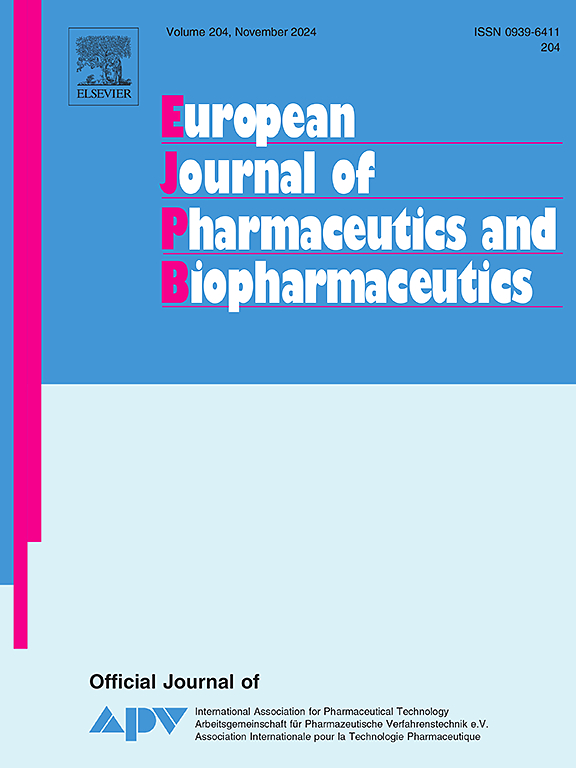口服载波生坦SNEDDS和S-SNEDDS片的性能:小鼠生物分布、肺动脉高压大鼠模型超声心动图和组织学研究
IF 4.4
2区 医学
Q1 PHARMACOLOGY & PHARMACY
European Journal of Pharmaceutics and Biopharmaceutics
Pub Date : 2025-04-23
DOI:10.1016/j.ejpb.2025.114725
引用次数: 0
摘要
一水波生坦(BOS)是治疗罕见肺动脉高压(PAH)疾病的首选分子。口服给药时,BOS溶解度低,变异性高。本研究评估了负载bos的SNEDDS和负载bos的S-SNEDDS片剂的药效学、生物分布、超声心动图和组织学结果。口服给药后,对雄性Balb/c小鼠(8周龄,18-20 g)进行药效学生物分布研究。XenoLightTM DiR和VivoTag®680XL荧光染料使用In Vivo Imaging System®(IVIS®)监测生物分布和吸收。采用Wistar大鼠(8-10周龄,250-300 g)进行药效学超声心动图和组织学研究。采用MCT腹腔注射1剂量(60 mg/kg)成功诱导PAH大鼠模型。对照药Tracleer®125 mg片剂和bos负载的SNEDDS片、S-SNEDDS片以50 mg/kg剂量给药;治疗组每天2毫升。药效学生物分布研究表明,体内实时生物分布、器官的离体感兴趣区域(ROI)值和总荧光发射增加(p <;0.05)。经证实,该制剂经淋巴系统进入体循环,在肝脏无首过效应,在肝脏无排出。超声心动图研究进行了长达14天,在参考片(Tracleer®)、bos加载的SNEDDS和bos加载的S-SNEDDS片(p >;0.05)。采用苏木精和伊红(H&;E)染色及免疫组化(IHC)染色进行组织学研究。这些研究表明,负载bos的配方对肺和肝组织的组织病理现象具有相似的治疗效果。组织学评价结果显示,在组织学参数的改善方面,低剂量制剂比相同剂量的对照片更有效(p <;0.05)。体外和体内的综合比较研究表明,与参比产品相比,bos负载制剂可能是治疗多环芳烃的替代口服给药系统。本文章由计算机程序翻译,如有差异,请以英文原文为准。

Performance of oral Bosentan-loaded SNEDDS and S-SNEDDS tablets: Biodistribution in mice, echocardiography and histology studies in pulmonary arterial hypertension rat model
Bosentan monohydrate (BOS) is the most preferred molecule for treating the rare pulmonary arterial hypertension (PAH) disease. BOS shows low solubility and high variability when administered orally. This study evaluated the pharmacodynamic biodistribution, echocardiography, and histology results of BOS-loaded SNEDDS and BOS-loaded S-SNEDDS tablets. Pharmacodynamic biodistribution studies were conducted with male Balb/c mice (8 weeks old, 18–20 g) after oral administration. XenoLightTM DiR and VivoTag® 680XL fluorescent dyes were used to monitor biological distribution and absorption with the In Vivo Imaging System® (IVIS®). Pharmacodynamic echocardiography and histology studies were carried out with Wistar rats (8–10 weeks old, 250–300 g). The PAH rat model was successfully induced with monocrotaline (MCT), which is one dose (60 mg/kg) was intraperitoneally injected. The reference drug (Tracleer® 125 mg tablet) and BOS-loaded SNEDDS and S-SNEDDS tablets were administered as 50 mg/kg; 2 mL per os to the treatment groups. Pharmacodynamic biodistribution studies showed that real-time biodistribution in the body, ex-vivo region of interest (ROI) values of organs, and total fluorescence emission were increased (p < 0.05). It has been confirmed that the formulations enter the systemic circulation via the lymphatic system, do not have a first-pass effect in the liver, and show no emission in the liver. The echocardiographic study was performed for up to 14 days and no difference was found between the treatment groups which are the reference tablet (Tracleer®), BOS-loaded SNEDDS, and BOS-loaded S-SNEDDS tablet (p > 0.05). Hematoxylin and Eosin (H&E) and Immunohistochemical (IHC) staining were done for the histology studies. These studies showed that the BOS-loaded formulations have a similar therapeutic effect on histopathological phenomena in lung and liver tissues. As the histological evaluation results, lower-dose formulations were found to be more effective than the same dose reference tablet in terms of improvements in histological parameters (p < 0.05). Comprehensive and comparative in vitro and in vivo studies indicate that BOS-loaded formulations could be an alternative oral drug delivery system for PAH treatment compared to the reference product.
求助全文
通过发布文献求助,成功后即可免费获取论文全文。
去求助
来源期刊
CiteScore
8.80
自引率
4.10%
发文量
211
审稿时长
36 days
期刊介绍:
The European Journal of Pharmaceutics and Biopharmaceutics provides a medium for the publication of novel, innovative and hypothesis-driven research from the areas of Pharmaceutics and Biopharmaceutics.
Topics covered include for example:
Design and development of drug delivery systems for pharmaceuticals and biopharmaceuticals (small molecules, proteins, nucleic acids)
Aspects of manufacturing process design
Biomedical aspects of drug product design
Strategies and formulations for controlled drug transport across biological barriers
Physicochemical aspects of drug product development
Novel excipients for drug product design
Drug delivery and controlled release systems for systemic and local applications
Nanomaterials for therapeutic and diagnostic purposes
Advanced therapy medicinal products
Medical devices supporting a distinct pharmacological effect.

 求助内容:
求助内容: 应助结果提醒方式:
应助结果提醒方式:


